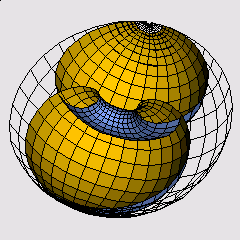

 |
 |
Two members of the 1-parameter family of discrete catenoid cousins are shown.
Surfaces of constant mean curvature (cmc) are special isothermic surfaces and various features of cmc surfaces can be interpreted in terms of the transformation theory of isothermic surfaces. For example, the Lawson correspondence between cmc surfaces in space forms can be viewed as a special case of the conformal deformation (Calapso transformation) of isothermic surfaces [6§3.3.7] and the (local) Weierstrass representation for minimal surfaces appears as a special case of the Goursat transformation for isothermic surfaces (a generalization of Goursat's classical transformation for minimal surfaces in Euclidean space) [6§5.3.12].
In this realm, smooth cmc-1 surfaces in hyperbolic space can be characterized in two equivalent ways: as isothermic surfaces that can be conformally deformed to a minimal surface in Euclidean space (i.e., have a minimal Calapso transform) [6§5.5.29], or as isothermic surfaces that have a totally umbilic Darboux transform, which is then the hyperbolic Gauss map of the cmc-1 surface (in this situation, the enveloped sphere congruence is the conformal Gauss map of the surface that, as a consequence, consists of horospheres: thus cmc-1 surfaces are "horospherical surfaces") [5, 6§5.4.24 and §5.6.13)]. The equivalence of the two definitions relies on one of Bianchi's permutability theorems, intertwining the Christoffel, Darboux and Calapso transformations, see [1] and [6§5.6.10]. Bryant's representation [3], cf. [9], of cmc-1 surfaces in hyperbolic space can then be recovered as a special case of the Darboux transformation, cf. [6§5.4.8] and [4] (as Darboux's linear system can, in the case at hand, be written as a complex system, cf. [6§5.6.21]).
Defining discrete isothermic nets as quadrilateral nets with factorizing cross ratios, see [2], as a discrete analogue of a curvature line parametrization of an isothermic surface, the transformation theory for smooth isothermic surfaces carries completely over to the discrete case, see [6 Ch.5]. In particular, Bianchi's permutability theorems carry over so that, as in the smooth case, discrete horospherical nets can equivalently be defined as Darboux transforms of discrete isothermic nets in a sphere (which yields the hyperbolic Gauss map and the ideal boundary of hyperbolic space as its target sphere) or as Calapso transforms of discrete minimal nets in Euclidean space (which are defined as Christoffel transforms of isothermic nets in a sphere), see [6§5.7.37]. Now, similarly to the smooth case, a Bryant type representation for discrete horospherical nets (along with their hyperbolic Gauss maps) from dual pairs of discrete isothermic nets in the plane (i.e., "discrete holomorphic maps") is obtained, cf. [6§5.7.37] and [7].
The presented model provides members of the 1-parameter family of Calapso transforms of a discrete minimal catenoid in Euclidean space; the discrete nets are constructed via the discrete Bryant type representation from the exponential map and its reciprocal on a square lattice as a Christoffel pair of discrete holomorphic maps. Two members of this 1-parameter family are shown: one embedded net (negative spectral parameter) and a non-embedded horospherical net (positive spectral parameter); an animation of the family is available in the file dcc_animation.mpl (referenced below; the animation can be viewed using Javaview or can be imported into Maple).
When the spectral parameter approaches 0 the discrete nets degenerate to a pair of horospheres that touch [8]; note how, for small values of the parameter, the horospherical nets start to resemble a minimal catenoid in Euclidean space: in the animation the domain has been fixed and the nets degenerate to the touching point of the two spheres but, when appropriately rescaled, they converge to a discrete catenoid (cf. [7] to observe a similar behaviour of the family of a discrete Enneper surface). The apparent second singularity in the family shown in the animation is caused by the scaling of the surfaces: for a certain (positive) value of the spectral parameter, the non-embedded nets become a cylinder and, starting with the cylinder, loose their rotational symmetry. Note that, in contrast to [8], we consider all surfaces/nets in the Lawson family of the catenoid. In the smooth case, all surfaces of the family (in our wider sense) are, as isothermic channel surfaces (their common Calapso potential is a function of one parameter only), invariant under a 1-parameter group of Möbius transformations; in the discrete case, proof of a corresponding fact seems still to be open.
Model produced with: Maple v9, JavaView v3.94.003
| Keywords | catenoid cousin; equivariant surface; constant mean curvature; hyperbolic space; discrete isothermic net; horospherical net; hyperbolic Gauss map; associated family; Lawson correspondence; Weierstrass representation; Bryant representation | |
| MSC-2000 Classification | 53A10 (53C42) | |
| Zentralblatt No. | 05613401 |
Submitted: Tue Apr 18 10:32:24 CEST 2006.
Revised: Tue Jun 3 10:47:51 CEST 2008.
Accepted: Tue Aug 12 14:02:57 CEST 2008.
University of Bath
Department of Mathematical Sciences
University of Bath
Bath, BA2 7AY
United Kingdom
u.hertrich-jeromin@maths.bath.ac.uk
http://www.maths.bath.ac.uk/~masuh/